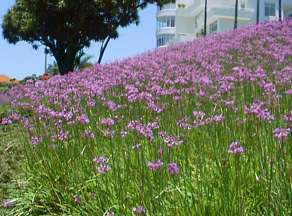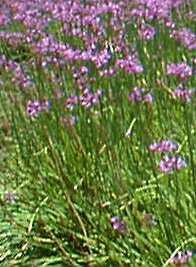Tulbaghia violacea
Tulbaghia violacea Harv.
Family: Amaryllidaceae
Common names: wild garlic, society garlic (Eng.); wildeknoffel, wildeknoflok (Afr.); utswelane (Xho.); isihaqa, incinsini, (Zul.)
Introduction
This is a popular garden plant that is useful for difficult hot corners of the garden as it will tolerate prolonged drought, although it flourishes with regular watering.

Description
Description
Tulbaghia violacea is a fast-growing, bulbous plant that reaches a heightof 0.5 m. The leaves are long, narrow, strap-like, slightly fleshy and smell strongly of garlic when bruised. They grow from fat, tuberous roots which spread to form clumps of plants. The pinkish-mauve tubular flowers, clustered into umbels of up to 20 flowers, are held above the leaves on a tall flower stalk, and appear ove a long period in summer (January to April). They too smell of garlic when picked. The fruit, triangular capsules, are grouped into a head, and when ripe they split to release the flattened, hard black seeds.

Conservation Status
Status
Least Concern (LC), Tulbaghia violacea is not threatened.
Distribution and habitat
Distribution description
This drought-resistant plant stretches from the Eastern Cape, KwaZulu-Natal and Limpopo, to as far north as Zimbabwe.
Derivation of name and historical aspects
History
Tulbaghia is named after Ryk Tulbagh (died 1771), governor of the Cape of Good Hope, and violacea means violet-coloured. Only two species are grown as ornamentals and enjoy popularity in cultivation.
Ecology
Ecology
Most of the species of Tulbaghia are adapted for moth pollination and have dull flowers that become sweetly scented at night. T. violacea seems likely to be pollinated by butterflies and bees as they are scented during the day.
Uses
Use
This attractive plant is ideal for the herb garden, as both the leaves and flowers can be used in salads and other dishes. The crushed leaves may be used to help cure sinus headaches and to discourage moles from the garden (by their strong smell). The smell repels fleas, ticks and mosquitoes when crushed on the skin.
The fresh bulbs are boiled in water and the decoctions are taken orally to clear up coughs and colds. The bulb has been used as a remedy for pulmonary tuberculosis and to destroy intestinal worms. Wild garlic may prove to have the same or similar antibacterial and antifungal activities as has been scientifically verified for real garlic. The leaves are used to treat cancer of the oesophagus.
The Zulus use the leaves and flowers as spinach and as a hot, peppery seasoning with meat and potatoes. They also use the bulb to make an aphrodisiac medicine. Wild garlic is a very good snake repellent and for this reason the Zulus plant it around their homes.
Growing Tulbaghia violacea
Grow
Tulbaghia violacea grows very easily in most soils. It can be used as an edging plant, along a pathway, and displayed to great advantage in a rockery. It can also be mass planted to form a groundvcover in sunny or partially shaded positions. It thrives in well-drained soil containing plenty of compost.
Propagate from seed or by dividing larger clumps. The hard black seeds are best sown in spring in deep seed trays and can be planted out during their second year. Once the clumps that have been divided are planted, they should be left undisturbed for as long as possible. First flowering can generally be expected in the second or third year.
Tulbaghias seldom fall prey to pests and diseases, but slugs and snails can cause considerable damage to the foliage.
References
- Borchers, H. 1996. Greening the KwaZulu-Natal midlands. SHARE-NET, Wildlife Society of Southern Africa, Howick.
- Du Plessis, N. & Duncan, G. 1989. Bulbous plants of southern Africa. Tafelberg, Cape Town.
- Dyson, A. 1998. Discovering indigenous healing plants of the herb and fragrance gardens at Kirstenbosch National Botanical Garden. The Printing Press, Cape Town.
- Hyam, R. & Pankhurst, R. 1995. Plants and their names: a concise dictionary. Oxford University Press
- Joffe, P. 1993. The gardener's guide to South African plants. Tafelberg, Cape Town.
- Manning, J., Goldblatt, P. & Snijman, D. 2002. The color encyclopedia of Cape bulbs. Timber Press, Portland.
- Van Wyk, B-E., Van Oudtshoorn, B. & Gericke, N. 1997. Medicinal plants of South Africa. Briza Publications, Pretoria.
Credits
Shireen Harris
Free State National Botanical Garden
September 2004
Plant Attributes:
Plant Type: Bulb, Ground Cover
SA Distribution: Eastern Cape, KwaZulu-Natal, Limpopo
Soil type: Loam
Flowering season: Early Summer, Late Summer
PH: Acid, Alkaline, Neutral
Flower colour: Mauve/Lilac
Aspect: Full Sun
Gardening skill: Easy
Special Features:
Horticultural zones










Rate this article
Article well written and informative
Rate this plant
Is this an interesting plant?
Login to add your Comment
Back to topNot registered yet? Click here to register.